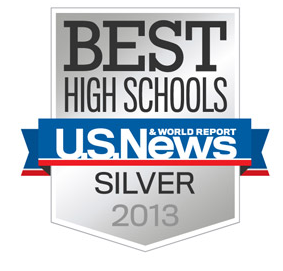
by Tena Starr
copyright the Chronicle 5-1-13
Lake Region Union High School has been named the third best public high school in Vermont for 2013 by U.S. News and World Report, which annually ranks high schools throughout the country. Last year it ranked Lake Region seventh best in Vermont.
For 2013, Lake Region is number 1,223 out of the 21,035 public schools in 49 states and the District of Columbia that were reviewed — all of the U.S. public high schools with enough data to analyze.
Montpelier High School is considered the best high school in Vermont, with Oxbow second. In order to receive a ranking, a school must be rated a gold, silver, or bronze medal school. In Vermont this year, nine schools earned a silver medal, and three earned a bronze. The rest were not ranked.
Lake Region Principal Andre Messier said he’s certainly proud. Like any set of statistics, you take them for what they’re worth, the good and the bad, he said. But he noted that the rankings are done by a reputable organization that looks at a wide variety of factors, not just test scores.
The U.S. News ranking takes into account eleventh-grade scores from the New England Common Assessment Program (NECAP) tests, but it also looks at how well the school serves all of its population — not just the college bound — at how many kids are at an economic disadvantage, and how students perform given their socioeconomic circumstances.
Mr. Messier said it’s in that area, in particular, that he believes Lake Region has made great progress and excels.
Lake Region appears to have closed the achievement gap between haves and have-nots, he said. In fact, recent test data indicates that poorer students have tested higher than their more advantaged classmates at Lake Region
“When you look at the disaggregated data, the free and reduced lunch students had a higher percentage of proficiency,” Mr. Messier said.
“That’s not supposed to happen. I guess we’re an example of it doesn’t matter what your social background is — if you’re impoverished, or your parents are divorced, you can still succeed.”
He said he wants young people to have choices when they leave Lake Region. “We’ve worked hard to give kids that confidence that when they leave here, despite these barriers, despite these red flags, they can succeed.
“Our elementary schools play a key part in that as well,” Mr. Messier said. “Lake Region is getting the recognition, but it’s everyone, it’s the whole supervisory union. It goes back to our communities who support our schools. They want to make sure kids have a quality education, and that can’t be said for everywhere.”
The U.S. News report is the result of a collaboration with the Washington-based American Institutes for Research (AIR), one of the biggest behavioral and social science research organizations in the world, according to U.S. News.
The rankings are based on the principle that a “great high school must serve all of its students well, not just those who are college-bound, and that it must be able to produce measurable academic outcomes to show the school is successfully educating its student body across a range of performance indicators,” says a U.S. News article, explaining how the rankings are calculated.
The first step in the process is to determine whether each school’s students are performing better than statistically expected for the average student in the state.
For the schools that make it past that step, the next is an examination of how well their least-advantaged students are doing compared to the state average.
Schools that get through the first two steps are then judged on college readiness, using Advanced Placement or International Baccalaureate test data. College level classes are offered in high school through both programs.
That third step measures which schools produce the best college-level achievement for the highest percentages of their students.
The report offers the following information about Lake Region:
Its student-teacher ratio is 12 to one, which is higher than the state average. The school has 31 teachers and 379 students.
Twenty-seven percent of the students tested for college readiness passed.
Thirty-four percent of the students tested were deemed proficient in math, which is near the Vermont average. And 81 percent of students tested were considered proficient in reading, which is above the state average.
About 52 percent of Lake Region’s students are considered economically disadvantaged.
Montpelier, ranked the top school in Vermont, had 80 percent proficiency in reading and 56 percent proficiency in math, with 26 percent economically disadvantaged.
Oxbow, which serves Bradford and Newbury, tested 80 percent proficient in reading and 35 percent proficient in math, with 41 percent of students economically disadvantaged.
Mr. Messier noted that in high school only eleventh-graders take NECAP tests. In the elementary schools, several grades take them.
“When we’re consistently seeing our scores up there year in and year out with completely different class profiles, that’s an indication of your program rather than, oh, you’ve got a smart class this year,” Mr. Messier said.
contact Tena Starr at [email protected]
For more free articles from the Chronicle like this one, see our Editor’s Picks pages. For all the Chronicle’s stories, pick up a print copy or subscribe, either for print or digital editions.







